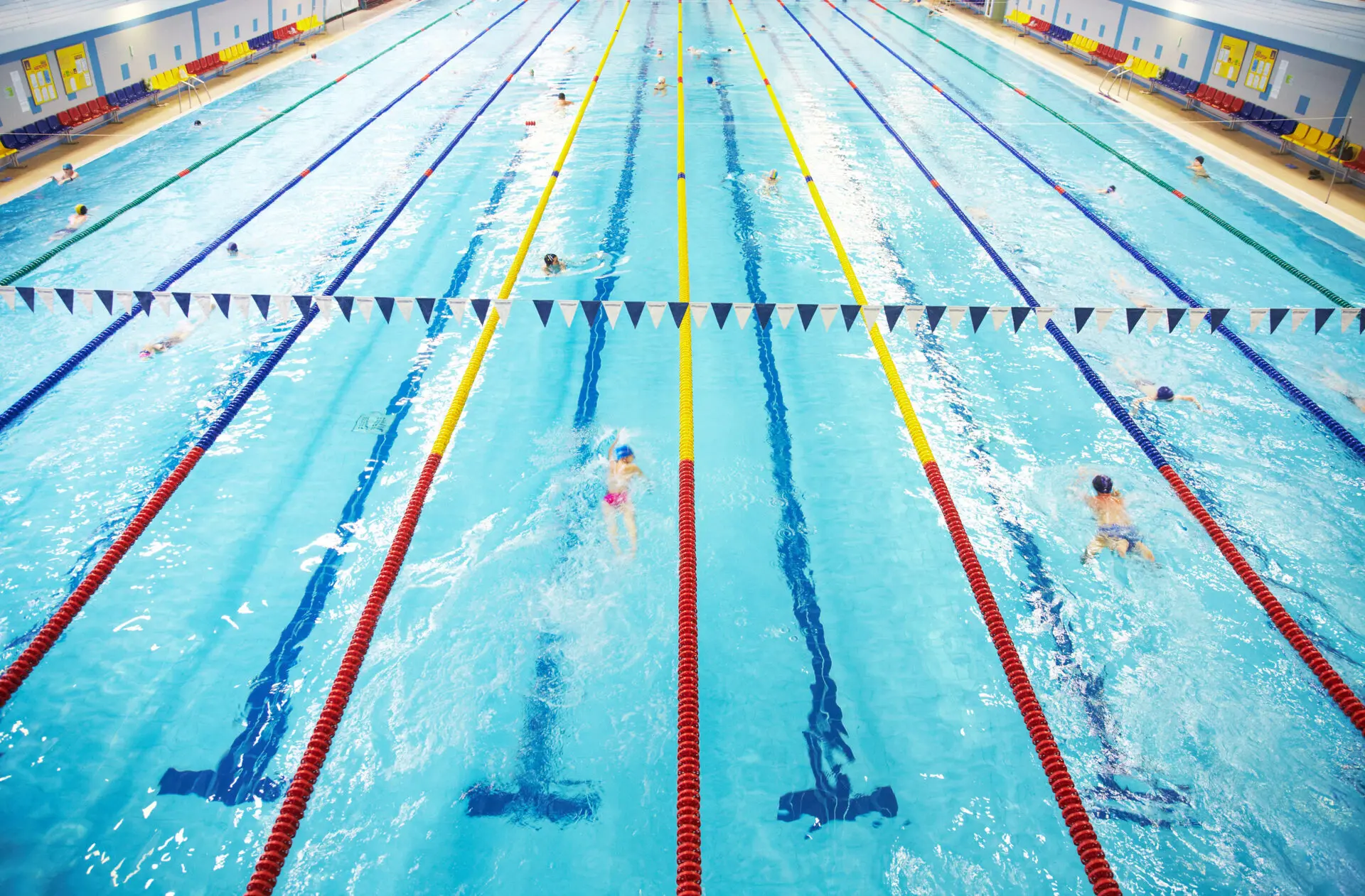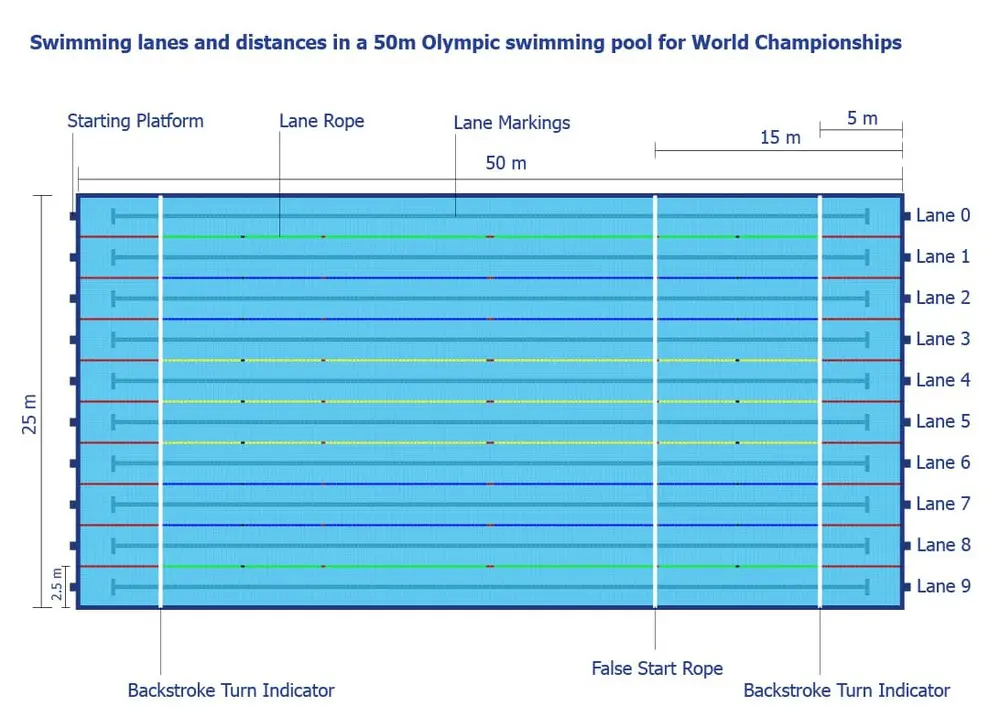Swimming is not only a great way to stay in shape and maintain good health but also an immensely popular competitive sport on a global scale. Swimmers who perform their workout routines in sport clubs, and indeed competitive sports people and professional athletes, understand the importance of having dedicated swimming lanes. This comprehensive guide provides all the essential information regarding swimming lanes and its regulations.
Floating lane ropes and markings on the pool bottom mark out each swimming lane. Every swimming lane can serve multiple purposes. These include keeping swimmers in line and preventing collisions , playing a crucial role in reducing the risk of accidents and injuries in the pool. Lane ropes are usually made of plastic and are anchored to the side of the pool. They can be removed and adjusted according to the required number of lanes.
When installing swimming lanes, several factors need consideration such as the pool’s size and shape, the number of swimmers who will use the pool, the type of lane rope material, and the intended use of the pool facility. Here, we cover exactly what you need to know in an accessible, at-a-glance format.
Dive deeper with the eBook
Swimming lane regulations for competition events
The rules and regulations for swimming lanes vary depending on the type of swimming event that will take place in the pool. To host official competitions, it is necessary to adhere to the guidelines provided by the World Aquatics Federation (formerly known as FINA).
These regulations are essential to ensure that the pool meets the required standards for competitive swimming events. The Facilities Rules provide guidelines on the number of lanes required for specific events, the length and width of the lanes, the distance between the lane ropes, and the colour of the lane markings.
Following the Facilities Rules not only ensures the safety of the swimmers but also ensures that the competition is fair and unbiased for all participants. We’ll outline them for you below.
Swimming in regular competitions
Swimming lane dimensions
While there is no minimum number of lanes required, each lane must be at least 2.5 metres wide. The first and last lanes, however, may be slightly narrower at 2.4 metres, with 0.1 metre-wide spaces on either side of them.
Lane rope configuration
Lane ropes are an essential aspect of separating lanes and reducing waves in the pool. They must be designed to minimise waves and must extend the entire length of the course. Components that do not contribute to wave reduction, such as tension springs and take-up reels, must measure less than 200mm at each end of the rope.
The diameter of the lane rope must be a minimum of 0.10m and a maximum of 0.15m.
To secure the lane ropes in place, facilities should use anchor brackets recessed into the end walls. If the anchor placement is on the pool deck the facility should use a non-elastic extender. The lane rope must remain in the pool water, and the anchor should not extend more than 10mm into the pool. Additionally, it must not affect the length of the lane rope by more than ± 10mm at each end.
To ensure proper wave reduction, the wave-reducing components at each end of the pool must be positioned 50% below the surface of the water. Anchors should be installed to withstand 20kN. Each lane rope must consist of wave-reducing components that are placed end-to-end, with a minimum diameter of 0.10 metres. The design of the discs and floats must not affect the length of the lane rope. The length of the lane rope must have negative buoyancy so that at least one-half to a maximum of two-thirds of the height of the wave-reducing components is beneath the water’s surface.
The take‐up reel of the lane rope should require a tool to lock tensioning into position and to prevent non‐authorized tampering. The lane rope shall be equipped with a tension spring, absorbing sudden high point loads and a wire withstanding a tensile force of 12kN.
In an eight-lane swimming pool, the colour of the lane ropes should be as follows:
- Two green ropes, for lanes 1 and 8
- Four blue ropes, for lanes 2, 3, 6 and 7
- Three yellow ropes, for lanes 4 and 5
- The components extending for a distance of 5 metres from each end of the pool should be red.
The lane ropes shall be firmly stretched and the tensions should be 1‐1,2kN. At the 15‐metre mark from each end wall of the pool the components shall be distinct in colour from the surrounding components. In 50 metre pools the components shall be distinct to mark 25 metres.
Lane numbers of soft material may be placed on the lane ropes at the start and turning end of the pool.
Swimming lane marking specifications
The swimming lane markings must be a dark contrasting colour, placed on the floor of the pool in the centre of each lane. Their dimensions should be as follows:
- Width: minimum 0.2 metres, maximum 0.3 metres.
- Length: 46 metres for 50-metre-long pools; 21 metres for 25-metre-long pools.
- The distance between the centre points of each lane should be 2.5 metres.
Each lane line should end 2 metres from the end wall of the pool with a distinctive cross-line that is 1 metre long and of the same width as the lane line. The distance between the centre points of each lane shall be 2.5 metres.
Target lines must be placed on the end walls or touch panels, in the centre of each lane, and of the same width as the lane lines. They must extend without interruption from the deck edge to the floor of the pool, to a maximum of 3 metres, with a cross-line 0.5 metres long placed 0.3 metres below the water surface, measured to the centre point of the cross-line.
Cross-lines 0.5 metres long should also be placed at the 15-metre mark from each end of the pool for 50-metre and 25-metre pools constructed after January 1, 2006. After October 2013, this shall be measured from the end wall to the centre point of the cross line.

Swimming in Olympic Games and World Championships
Swimming lane dimensions
- 8 lanes of 2.5 metres wide
- Two spaces 2.5 metres wide outside of lanes 1 and 8
- Lane ropes separate the spaces from lanes 1 and 8
World Championships in permanent swimming pools (10 lanes total):
- Lanes 1-8 are 2.5 metres wide
- Lanes 0 and 9 are 2.4 metres wide
- Two spaces 0.1 metres wide outside of lanes 0 and 9
- Lane ropes separate the spaces from lanes 0 and 9
World Championships in temporary swimming pools:
- Lanes are 2.5 metres wide
- Two spaces 0.5 metres wide outside of lanes 0 and 9
- Lane ropes separate the spaces from lanes 0 and 9
Lane rope configuration
The full length of the course must have lane ropes. Components not contributing to wave reduction must measure less than 200mm at each end of the rope, secured at each end wall to anchor brackets. If anchor placement is on the pool deck, an extender – firm and non-elastic – should be in place.
The installed lane rope should stay in the pool water. The anchor, including the extender, should not extend more than 10mm into the pool, not influencing the length of the lane rope by more than ± 10mm at each end of the rope. The anchor should be positioned so that wave-reducing components at each end wall of the pool are 50% below the surface of the water. Anchors should be installed to withstand 20kN.
Each lane rope will consist of wave-reducing components placed end-to-end with a diameter of 0.15 metres. The design of discs and floats should be such that the floats do not influence the length of the lane rope. A float should be an integral part between two discs. The lane rope length of the course shall have a negative buoyancy such that at least one-half to a maximum of two-thirds of the height of the wave-reducing components should be beneath the water surface.
The take-up reel of the lane rope should require a tool to lock tensioning into position and prevent tampering. The lane rope should be equipped with a tension spring to absorb sudden high point loads, and a wire that withstands a tensile force of 12kN. Components extending for a distance of 5 metres from each end of the pool should be red. The lane ropes shall be firmly stretched and the tensions should be 1‐1,2kN
Lanes rope colours for Olympic Games (eight lanes):
- 2 green ropes, for lanes 1 and 8
- 4 blue ropes, for lanes 2, 3, 6, and 7
- 3 yellow ropes, for lanes 4 and 5
Lane rope colours for World Championships (ten lanes):
- 2 green ropes, for lanes 0 and 9
- 6 blue ropes, for lanes 1, 2, 3, 6, 7, and 8
- 3 yellow ropes, for lanes 4 and 5

At the 15‐metre mark from each end wall of the pool the components shall be distinct in colour from the surrounding components. In 50 metre pools the components shall be distinct to mark 25 metres.
Lane numbers of soft material may be placed on the lane ropes at the start and turning end of the pool.
Swimming lane marking specifications
Dark contrasting colour lane markings should be placed on the floor of the pool in the centre of each lane in the following configuration:
- Width: minimum 0.2 metres, maximum 0.3 metres.
- Length: 46 metres for 50-metre-long long pools ; 21m for 25-metre-long pools.
- Each lane line should end 2 metres from the end wall of the pool with a distinctive cross line 1 metre-long and of the same width as the lane line. The distance between the centre points of each lane shall be 2.5 metres.
Target lines and cross line regulations are the same as the ones explained for regular swimming competitions.
Regulations and proper maintenance: essential to fair and safe competitions
Swimming lanes play a crucial role in regulating competitive events and preventing accidents and injuries in the pool. The configuration of each swimming lane is dependent on various factors such as the size and shape of the pool, the type of material used for lane ropes, and the intended use of the pool facility.
The World Aquatics Federation Facilities Rules provide guidelines on the number of lanes required for specific events, the length and width of the lanes, the distance between the lane ropes, and the colour of the lane markings. The maintenance of lane ropes and swimming lanes is also essential to ensure that they last as long as possible. Regular cleaning with a mild detergent and soft brush can eliminate dirt and debris, while keeping the lanes adequately tensioned prevents sagging or drooping.
Understanding the regulations and specifications outlined in this guide is essential for ensuring that swimming lanes are configured and maintained appropriately for their intended use. For pool planning, components, and maintenance solutions, there’s Fluidra.
